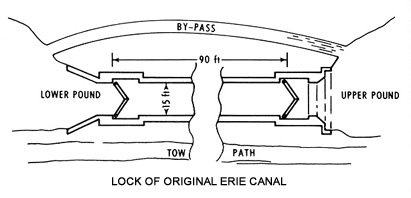
With the opening of the Erie Canal in 1825, New York vaulted past Philadelphia as the largest city and busiest port in America. The economic importance of canals had been amply demonstrated in England in such projects as the Bridgewater Canal in 1761, and numerous major canals had been proposed in the U.S. However the scale of a canal from the Hudson to Lake Erie was unprecedented
Insert
Size of the Locks
from http://www.eriecanal.org/locks.html
The original Erie Canal locks were 90 feet long and 15 feet wide, and were designed for a canal boat 61 feet long and 7 feet wide, with a 3 1/2 foot draft.

[From: Hydrology and Environmental Aspects of Erie Canal (1817-99) / by W. B. Langbein
(U.S. Govt. Printing Office, 1976 (Geological Survey Water-supply Paper 2038)) -- p. 24.]
The present Erie Canal rises 566 feet from the Hudson River to Lake Erie through 57 locks. From tide-water level at Troy, the Erie Canal rises through a series of locks in the Mohawk Valley to an elevation of 420 feet above sea-level at the summit level at Rome. Continuing westward, it descends to an elevation of 363 feet above sea-level at the junction with the Oswego Canal, and finally rises to an elevation of 565.6 feet above sea-level at the Niagara River.
The original "Clinton's Ditch" Erie Canal had 83 locks. The Enlarged Erie Canal, built between 1835 and 1862, saw this number reduced to 72 locks. Today, there are 35 numbered locks -- although Lock No. 1 is usually called the Federal Lock -- plus the Federal Black Rock Lock.
END INSERT
President Thomas Jefferson, calling it "a little short of madness," thought the proposal for such a canal was
ridiculous and rejected it. It was the entrepreneur Jesse Hawley who managed to interest the governor DeWitt Clinton and the plan went ahead. Due to the overwhelming perception that the plan was
absurd, the project became known as "Clinton's Folly" or "Clinton's Ditch." In 1817 Clinton was successful in convincing the New York State legislature to authorize the funds for building the
canal:
"The first section of the [Erie Canal] opened in 1819. And the entire project (including eighty-three locks enabling the rise of some 568 feet from the Hudson to Lake Erie) was destined to sit
finished by the end of October 1825.
"Once the Erie Canal opened, the entire logic of trade into, out of, and through the port of New York would be changed forever. As Roy Finch of the New York State Engineer and Surveyor Bureau
observed on the occasion of the hundredth anniversary of the canal's opening: 'After the building of the original canal the city of New York grew by leaps and bounds. Before the canal was built,
Philadelphia had been the nation's chief seaport, but New York soon took the lead and too late Philadelphia made heroic but futile efforts to regain supremacy.' Finch added that Massachusetts
'had been another rival having been about on par with New York State in exports.' Nevertheless, a mere sixteen years after the opening of the canal, Boston's exports were only one-third those
moving through New York. 'In that period, too, the value of real estate in New York increased more rapidly than the population while personal property was nearly four times its former value and
manufacturing three times as great. There were five times as many people following commercial pursuits in New York as there were before the completion of the Erie Canal.'
"Men of vision saw this boom coming. Indeed the boom was being counted upon to help pay off the massive $7 million investment it had taken to accomplish the terrific feat of engineering. Almost
more important than the straightforward logistical advantage of the Erie Canal, however, was the sheer heft and grandeur of the project, which captured the imaginations of average Americans and
made them feel inspired. Great things were possible; terrific accomplishment was indeed achievable - especially in the United States, a country with a brief past and a wide-open future. Not until
the late 1860s would another such project, the Transcontinental Railroad, seize the public mind so totally and offer a similar promise for changing the economic map."
Author: Edward J. Renehan, Jr.
Title: Commodore
Publisher: Basic
Date: Copyright 2007 by Edward J. Renehan, Jr.
Pages: 96-97
 DISCUSSION
GROUP
DISCUSSION
GROUP



Write a comment
Jiřik (Sunday, 15 July 2012 23:01)
THX for info